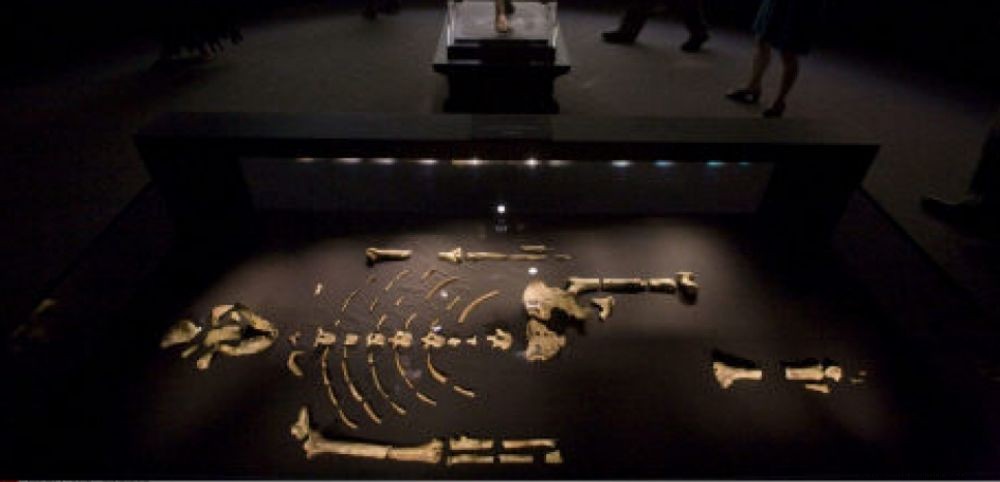 Lucy's skeleton, here on display in Houston in 2007, continues to fascinate researchers
Lucy's skeleton, here on display in Houston in 2007, continues to fascinate researchers "It looks like Lucy didn't kill herself by falling out of a tree. " Christophe Griggo, archaeozoologist and taphonomist at the Edytem laboratory of the University of Savoie-Mont-Blanc and lecturer at the University of Grenoble-Alpes has agreed to re-examine for Sciences et Avenir the skeletal elements of Lucy, the Australopithecus afrensis discovered in 1974 in the Ethiopian Afar. In a study published in Nature anthropologist John Kappelman, from the University of Texas at Austin (United States), believes that this arboreal and bipedal Australopithecine killed itself by falling from a tree, suffering multiple fractures in the process.
Christophe Griggo is a specialist in archaeozoology, the science that studies animal remains to understand their relationship with humans, but also in bone taphonomy. Taphonomy is a discipline that is concerned with all the natural or anthropogenic processes that can affect bones during fossilization, from the death of the animal until their discovery. His expertise allows him to determine if broken bones were caused by an accident ante mortem , or caused post mortem by landslides, reworkings or compaction of the land where the body of the animal was buried. He also studied tens of thousands of bones of prehistoric animals that had fallen into sinkholes (chasms), on which he was able to spot, in very rare cases, the unmistakable signature of a fall. Not so on Lucy, apparently.
Fresh bone, dry bone:different fractures
“Reading the article published in Nature and a thorough examination of the illustrations — plus more images of Lucy's skeleton — , makes me think that Kappelman and his colleagues are taking advantage of Lucy's notoriety to do the buzz, he points. The appearance of the various fractures or fissures indicates that they are most likely the result of taphonomic issues post-mortem.” And to list:“The head of the humerus, the tibial plateau, the sacrum, the pelvis, the distal tibia and the distal femur present crushing which could well correspond to sediment movements or sedimentary compaction .” Soil can compact under the weight of sediments or slide down a slope, even a very slight one, or even settle after the water has evaporated. “Fractures of long bones, such as the humerus, are very often perpendicular to the longitudinal axis of the bones, and above all the rather irregular appearance of the fractures is characteristic of a fracture on dry bones… therefore occurring for a long time after death.”
Christophe Griggo is surprised that John Kappelman did not look into the morphology of the fracture surfaces of long bones. “This is the essential observation that every archaeozoologist makes to distinguish breaks made on fresh bones from those made on dry bones, he explains. When a fresh bone has been broken, (during a fall, an accident or for the extraction of the marrow), we find spiral breaks and presenting surfaces smooth breaks. On the other hand, breaks (due to ground movements or sediment compaction) on dry bone, having lost all or part of its collagen, give breaks perpendicular or parallel to the axis of the bone, and surfaces irregular breaks.”
Trampled by a herd? Drowned?
The French researcher therefore shares the doubts expressed by Donald Johanson, of Arizona State University and Tim White, of the University of California at Berkeley, two American paleontologists who share the paternity of Lucy's discovery, he 42 years ago, with the French paleoanthropologist Yves Coppens.
Questioned by the Guardian , Donald Johanson believes that Lucy could just as well have been trampled by a herd after her death, before being covered by the sediments and gradually embedded in the rock. “There are myriad explanations for such fractures, protests the archaeologist. The scenario that she fell from the tree is just one of many [...] impossible to prove .” Tim White identifies the "cracks" in Lucy's skeleton as "routine damage to fossils" , as we see by the hundreds in the field. “If paleontologists were to apply the same logic and conclusion to the many mammals whose fossilized bones have been twisted, abused by geological forces, then we would also have gazelles, hippos, rhinos and tree-climbing elephants and falling from the branches”, ironically the paleontologist.
The mystery surrounding the circumstances of Lucy's death 3.2 million years ago is therefore far from clear. But one hypothesis remains valid:if the fossil reached us so complete with its 52 bones, it is probably because it was buried very quickly in the sediments which protected it from climatic alteration and scavengers. In the 1980s, researchers even imagined that Lucy, discovered in the alluvial deposits of an ancient river, could have died...drowned.
